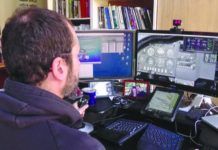ATC History
Which came first: the chicken or the Federal Egg Administration? Impossible to say. Physics teaches us that when Bernoulli found lift, his nemesis, Newton, said there must be an opposing reaction. So, when the Wright brothers flew, government pondered how to keep them from impacting all those other aeronauts. Little happened because of Newtons Law of Administrative Inertia: An agency at rest remains at rest until acted upon by an un-ignorable force. …
GPS: Safety of Flight
If you live west of the Mississippi, out where most of the military airspace and where most of the testing is done, youre well familiar with those pesky NOTAMs announcing interference testing of GPS or outright loss of the GPS signals. Most of us ignore them.
Briefing: August 2017
The Paris Air Show opened in June with the usual displays of military hardware and the latest passenger jets, but new and emerging technologies also attracted a lot of attention. Volocopter, a German company that has been developing a two-seat electric VTOL, announced it will work with the government of Dubai to test fly semi-autonomous air taxis by the end of this year. Boom unveiled the final design for a subscale prototype of its supersonic airliner, and said it will fly next year, with three GE engines. Airbus said its working on a new helicopter with a box-wing design that will cruise at 215 knots while maximizing efficiency. The Racer demonstrator will fly in 2020, Airbus said.
Readback: August 2017
In April Killer Quiz, The Prof and the Pilot, I dont think that the answer to the last question is correct. With tailwind, one should reduce the airspeed below best glide speed, which in turn reduces the sink rate. Gliders pilots are very familiar with these concepts.Unfortunately, Cessna doesnt publish sink rates at various speeds to compute that accurately, so we are left to back-of-the-envelope calculations. We know that at best-glide speed (65 knots.
An IPC through WINGS
There are three levels of WINGS: the Basic, Advanced, and Master phases. Each level has multiple phases. Unlike the previous program, multiple phases can be earned each year. To complete a phase, pilots must get three flight and three ground credits which can be chosen from a wide range of activities.
Briefing: July 2017
The FAAs BasicMed rule took effect on May 1, creating a new option for pilots who want to fly without an FAA medical certificate. Under the BasicMed rule, pilots can fly under certain circumstances without a medical certificate, but they must pass an online course about aviation medical issues, complete a medical exam and checklist, and meet certain other criteria. The FAAs Advisory Circular (AC 68-1) on Alternative Medical Qualifications describes in detail how pilots can comply with the new policy.
Readback: July 2017
I just got around to trying Jeff Van Wests IFR Sim Challenge from the Feb. 2017 issue. Its great! Many of us use desktop simulators like Prepar3d to practice instrument procedures. This makes it really challenging in a useful way. Please keep up this feature. Im sure it will only get better as you work on it.
Pilots Bill of Rights
In late 2010, experienced pilot and U.S. senator James Inhofe was issued a pilot violation by the FAA. Displeased with the violation process, he created and sponsored the Pilots Bill of Rights 1 and 2. The NTSB is supposed to be an impartial entity to which a pilot may appeal a certificate suspension or revocation. For decades, aviation attorneys have known this is not reality.
A Date With AIRAC
Maybe were too busy focusing on the forest and the trees that the dirt making up the foundation of the arbors is ignored. Or perhaps its the elephant in the room no one discusses. Instructors dont teach it because they dont understand the opaque system themselves-cant teach something you dont know. Whatever the cause, many pilots have a poor understanding of how aeronautical information travels through the system and how charts are updated.
IPC and ATC: We All Goof
After a few days of unusually nasty weather, the day of my postponed IPC dawned bright and clear. There wasnt even much wind. It was the perfect day to fly, and as it turned out, it seemed like just about every other pilot around thought the same thing. There was traffic everywhere and everyone wanted something different. I was caught in a perfect storm.
Across the Pond
On occasion I have a flight across the pond. No, its not an ocean crossing, although it sometimes feels like it. These flights cross Lake Michigan, and require a bit more planning than flights over land. When you fly around the Great Lakes, its taken for granted that if youre in a single-engine piston aircraft, you have to carefully examine the risks and mitigations. Dont want to cross the lake at all? Fly around it and spend that extra time to stay over land. Not good weather for a crossing? Same deal.
Circling versus Mins
The whole thing started when a reader asked about an approach to a Runway 26 that had the note, Rwy 26 Straight-in and Circling minimums NA at night. Why doesnt it just say the approach is NA at night? the reader asked. We agreed thats what it seemed to say, but we also wondered why it was said in so awkward a manner. So, we investigated and the answer we found surprised all of us.
















